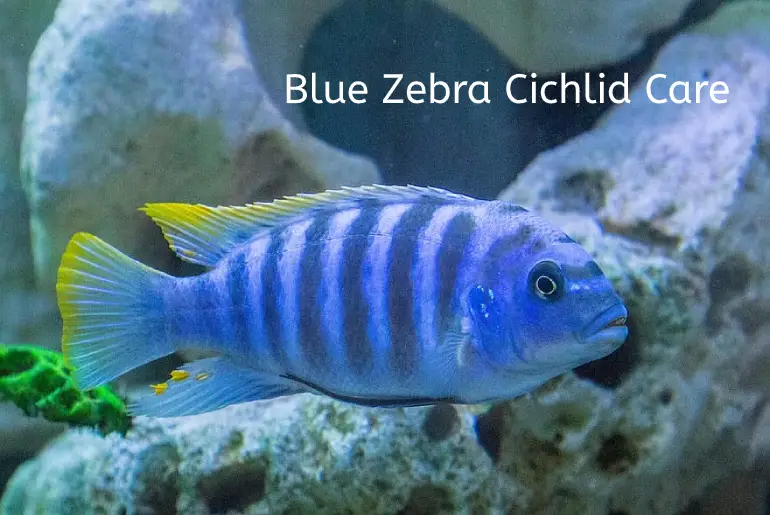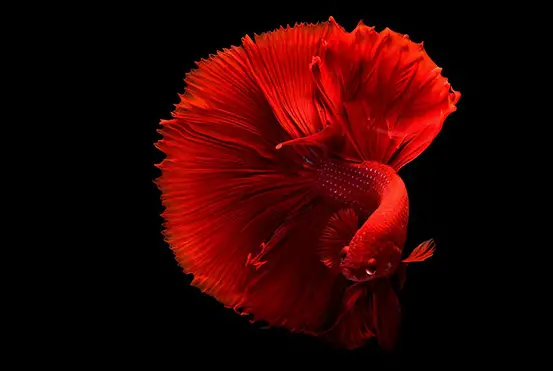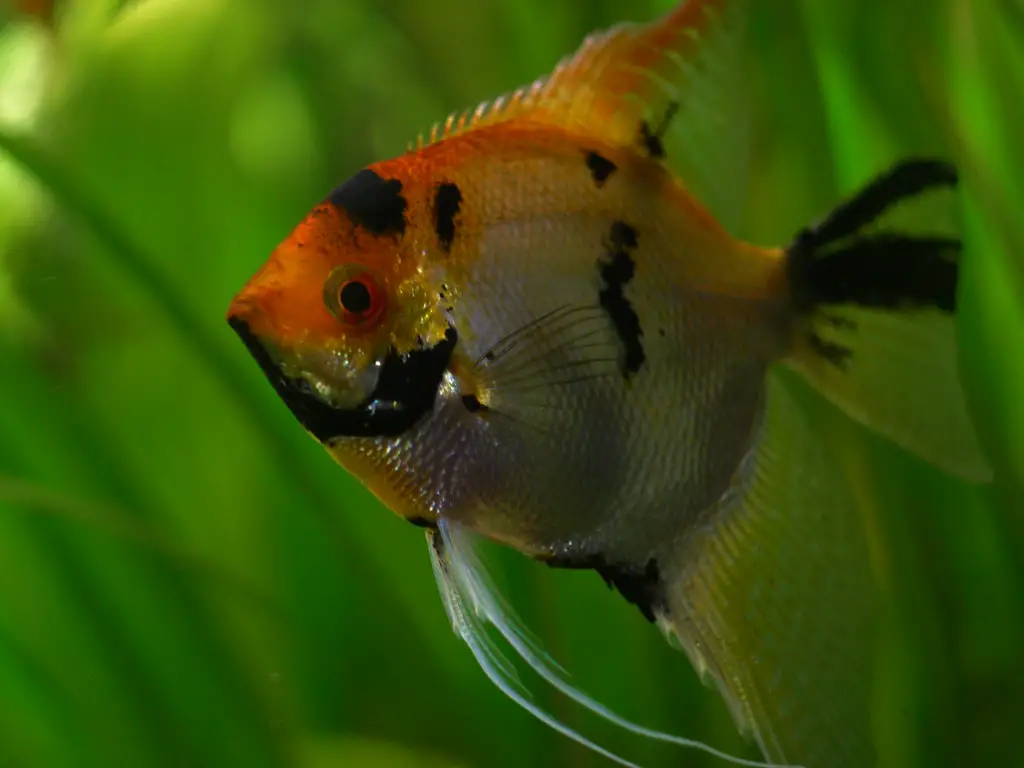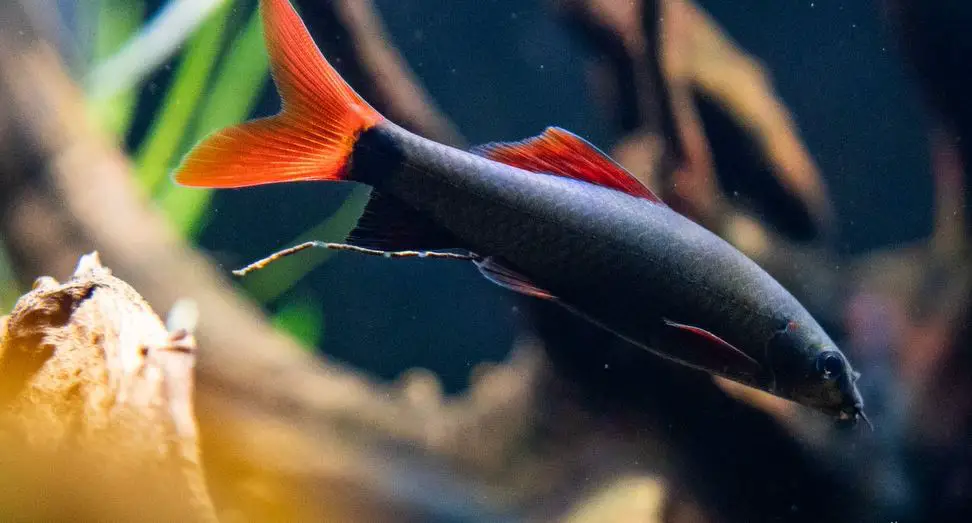Couldn’t resist Blue Zebra Cichlid’s beauty and want them in your cute decorated tank? And are you confused with how many Blue Zebra Cichlids to keep or just how to get these cichlids? I was there too.
From my knowledge, Blue Zebra Cichlids are captivating, ocean blue gorgeous, most lively, semi-aggressive, and pretty dominant. However, you still wish to have them, and I can totally feel you.
Out there in the aquatic world, there are millions of species of aquatic animals who are cheap, have vibrant color, are human-friendly, don’t require extra effort, and will make any aquarium more worthy. Then, why Blue Zebra Cichlid? I will answer your every ‘WHY’ and share some of my Blue Zebra Cichlid experience too. Then, you can relate to your experience as well.
As a fish lover myself, I collected different species over the years. I got attached, shared moments, secretly gossiped, made them listen for hours. And still, they left me with their depressing low life-span. But, blue zebra cichlid lives 10 years with proper care, temperature, and a constant healthy diet. Thus, it is already a plus point.
Blue Zebra Cichlid/ Cobalt Blue Zebra Cichlid As A Pet Fish
To give Blue Zebra Cichlid a house in your tank, let us enlighten you a little more about this blueish beauty. Natively known as Mbuna( An African for rockfish), Blue Zebra Cichlid originally is from East Africa(Lake Malawi), a country responsible for an ecosystem worldwide, which makes it even more interesting. If you find a shark-free lake there, then these cichlids are all happy swimmers.
As lively and boisterous Blue Zebra Cichlid are, they are equally dominant and territorial, and for that, your tank needs to be buzzed by larger fishes. Larger fish that could bring Blue Zebra Cichlid back to the ground else, these cichlids can start a small WWE inside your dream tank. To avoid this mess, keep your tank a little crowded.
Despite all, these lovely Blue Zebra Cichlid live longer than most fish I know. With 7.5 to 8.5 PH and hard alkaline water inside, your Cichlids are gonna feel loved and pampered, trust me. To maintain water pH level my previous article on how to maintain aquarium water pH level can help you out.
Quick Scan:
| Name | Blue Zebra Cichlid/Cobalt Blue Zebra Cichlid |
| Origin | Lake Malawi in East Africa |
| Colour | Ocean Blue/Grey/White |
| Size | From a normal egg size, they grow into 5 ½ to 6 inches(15cm) |
| Genus | Maylandia Callainos |
Species
While Blue Zebra Cichlids are one of the prominent fish in the aquarium world, the exact count of Blue Zebra Cichlids is unknown even today. However, for the category, these Cichlids fall under the M.zebra species.
Reproduction
Blue Zebra Cichlids are mouthbrooders! The reproduction process takes around a month.
Spines
Unlike other fish, Blue Zebra Cichlids have sixteen to nineteen spines to support their body.
Conservation Status
Worldwide, Blue Zebra Cichlids are the least concerned aquatic animal due to their huge number of population and are safe as well.
Nature/Behavior
As mentioned, Blue Zebra Cichlids are semi-aggressive, defensive, and territorial in nature.
Diet
Blue Zebra accepts almost every commercial food. However, adding vegetables to their diet is a necessity rather than an option—namely, vegetable flakes, spinach, and green work fine.
Related articles:
- Fish Food 101: A Beginner’s Guide On How To Feed Aquarium Fish
- Can Fish Eat Human Food: What Are They And How To Prepare Them?
- Obesity in Aquarium Fish: Are You Overfeeding Your Fish?
Lifespan
With a perfect blend of every prerequisite, Blue Zebra Cichlid can live up to 10 years.
Popularity
Blue Zebra Cichlids are goals in the aquarium world. People are actively stuck on the idea of having cichlids in their tanks. Therefore, these Cichlids are astoundingly popular among every age of fish enthusiasts.
Related articles:
- 20 Health Benefits of Keeping an Aquarium Fish At Home Or Office
- Benefits of Keeping Fish | Health Benefits, Vastu Shastra
Blue Zebra Cichlid Life Cycle
Just like any normal fish, Blue Zebra Cichlid comprises of six life stages, which are as below:
First Phase: Egg
The first stage where a very tiny embryo is developed after the egg is fertilized by male Blue Zebra Cichlid. The embryo then slowly starts to develop its organ inside the same egg.
This stage is not challenging for Blue Zebra Cichlid because most of their eggs survive the stage due to a suitable temperature. Temperature plays an important role in this stage.
Second Stage: Larvae
After eggs are hatched, tiny Blue Zebra Cichlids come out of the eggs, which are called larvae. Larvae emerge with attached small yolk sacs.
The yolk sac provides needed nutrition inside the egg. The food/ nutrition provides these Cichlid 2 to 4 days of survival until their eyes and mouth are developed. After the eyes and mouth are developed, they will not be dependent on the yolk sac.
Third Stage: Fry
Once the yolk sac is fully consumed, larvae turn into fry (younger fish) and are ready to start eating on their own from the outside world. That would be what you will be giving.
You can set up a separate fry tank to keep them safe. Get some information from The Easiest Way to Set up a Fry Tank: New Born Fry Care.
Fourth Stage: Juvenile
The end of the Fry stage is Juvenile, and a body is developed in this stage, their fins, tail, colors, or the structures are made or changed in this stage. However, it is also a point of high mortality, meaning where only a few survive.
Fifth Stage: Adult
The adult stage is commonly reviewed as the time of reproduction, sexually matured. Although sexual maturity depends on the life span of a fish. Blue Zebra Cichlid matures averagely at the age of 3 to 6, depending on the food, temperature, and the care they are receiving.
Final Stage: Spawning
This is known as the reproduction stage, where female Blue Zebra Cichlid releases eggs in the spawning site and male Blue Zebra Cichlid releases semen, which helps in the fertilization process.
Briefly, The end is the beginning, and the beginning is the end. If you are lucky, you might get a chance to take care of the new generation of your Blue Zebra Cichlid.
Can Blue Zebra Cichlid Fit In Your Tank?
You might have been convinced by now as Blue Zebra Cichlid could be an expensive idea for your current budget. I take that as a big No.
Tank Size
Considering at least 10 larger sizes of fish in your tank, let’s say you need a tank that must hold up to 75 to 100 gallons of water. So, don’t worry, no need to buy a new tank for Blue Zebra Cichlid, quite a money saver, right? Though, you can check out Aquatic Fundamentals 75-90 Gallon Aquarium Stand with Storage, Double Door Front Access, Serene Cherry, 36751-68-AMA.
Go through Aquarium Size and Weight Guide – A Shocking Truth if you want to have more ideas.
Similarly, setting up your tank is a whole work that requires time, money, and effort.
How Much of Decoration Is Enough?
As colorful, the combination is on the skin of Blue Zebra Cichlid, and your tank requires an initial effort to make your fish homely:
- Hiding place,
- Colorful stones (Blue Zebra Cichlid loves stone),
- Rock caves,
- Accessories: PIVBY Natural Aquarium Driftwood Assorted Branches Reptile Ornament for Fish Tank Decoration Pack of 3.
Give them the idea of the ocean while they are inside. Adorn as much as you can and as much as you want. Later, your alluring tank might act as a therapy to you.
How To Identify Male Or Female Blue Zebra Cichlid?
I would love to say the choice is yours, but just like humans, your Blue Zebras Cichlid needs a companion too. I mean, who does not? Don’t go for a male just because they have vibrant colors and are charismatic. It does not work this way.
To breed, to control male Blue Zebra Cichlid’s aggression, to keep them distracted, buy 2 to 3 extra females for a male Blue Zebra Cichlid. Keep the tank really busy.
And, how are Male or Female Blue Zebra Cichlid any different from one another? Well, males are a little more bright-looking little guy with sharp-pointed dorsal and anal fins. In contrast, females are a little dull blue and have a blunt-looking genital papilla. Along with these differences, males keep roaming and chasing around females just like humans.
Blue Zebra Cichlid’s Breeding/ Reproduction
This is new! A separate breeding aquarium is needed for breeding. It is okay even if it is a medium-sized pot, put some stones, rock caves, areas of the open substrate, and a few plants for decor. After your breeding pot is ready, place female and male Blue Zebra Cichlid in there.
Related articles:
- Nano Planted Aquarium Set up Guide: Everything You Need to Know
- Java Moss: Amazing Low Light Beginner Plant
- 9 Best Low Light Aquarium Plants | Benefits of Aquarium Plants
Initially, deep and different colors are displayed when a male Blue Zebra Cichlid is ready to breed. The female Blue Zebra Cichlid lays eggs and safely places them into the rock, a decided spawning site by the male.
Then, Male Blue Zebra Cichlids fertilize them by releasing milt (semen of a male fish). Afterward, the mother, Female blue Zebra Cichlid, holds larvae in her mouth for around 21 to 30 days or an extended period of time. The reason we call them mouthbrooder.
When female Blue Zebra Cichlid carries eggs in her mouth, she does not feed for the entire time and is easily stressed and weak. One of the reasons why there must be a separate breeding tank is because the brooding mother is stressed or feels tired.
Finally, after a long time, tiny Blue Zebra Cichlid starts floating in the water, total satisfaction to watch.
Blue Zebra Cichlid’s Tankmates
By now, you already know Blue Zebra Cichlid as a semi-aggressive creature. If not, they really are semi-aggressive in nature. Don’t let these Cichlid be the dominant one. Fill your tank with larger fish, or maybe any Mbuna (They are friendly with any Mbunas) that will keep Blue Zebra Cichlid confined and conscious. Nonetheless, at least 10 fishes are needed to maintain the crowd.
Besides maintaining the crowd, adorn your tank with hiding places, plants, colorful rock, and accessories. Let us fool these Cichlid’s brain. Let them imagine the ocean while they are inside.
I have Danios and Tetras to terrorize Blue Zebra Cichlid in my tank, just saying.
Related articles:
- Danio Fish Diseases And Treatment
- Longfin Leopard Danios: Everything You Need To Know
- Glowlight Tetra Breed Profile | Everything You Need To Know
How To Care For Blue Zebra Cichlid
You have almost mastered Blue Zebra Cichlid but, let us hold a Ph.D. now. Simple things to focus on while grooming Blue Zebra Cichlid, and here we go.
Temperature Adjustment
In general, Mbunas survive happily around 78°F to 80°F (21°C to 27° C). Although, I prefer 78°F as an ideal for my Blue Zebra Cichlid. You want to adjust the temperature because once my brother burned his goldfish at a high degree unintentionally, and he does not remember how much, and that is still sad to remember, even today.
For avoiding such mishaps, you can grab a heater like Hygger Titanium Tube Submersible Pinpoint Aquarium Heater with Digital Thermostat, IC Temp Controller 200W, and a thermometer like Fish Tank Thermometer, Touch Screen Digital Aquarium Thermometer with LCD Display, Stick-on Temperature Sensor ensures Optimum Temperature.
Feeding
Blue Zebra Cichlid is an easy fish. Blue zebra cichlid being a major herbivore, vegetables are a must in their diet and can be given as vegetable flakes or any fresh vegetables. They will love it.
Normally, for my grown-up Blue Zebra Cichlid, I feed them twice a day, but a baby or a growing fish can be treated thrice a day. Do not overfeed your Blue Zebra Cichlid just because you love fat and round Blue Zebra Cichlid in your tank.
Some of the best foods are:
- HBH Pisces Pros 8 Veggie Fish Food Flake (2 oz)
- Fluval Color Enhancing Flakes Fish Food, 4.94-Ounce, 140gm
Note:
Remember not to feed high protein food, bloodworm, and brine shrimp. From my experience, leafy Seawood and the New life Spectrum Thera+A are the best.
Filtration
There are a few ideas on my mind right now. First would be AquaClear Power Filter – 110 V, not very easy to clean the filter, but it does its work at best.
The second would be Bio-wheel Filter. This filter never clogs and nor needs to be replaced. Bio-wheel Filter follows advanced technology that will keep your aquarium ammonia-free and surround the aquarium with healthy bacteria.
Related articles:
- Aquarium Filter Media Type and The Arrangement
- Aquarium Filtration Methods | Aquarium Filter
- Can I Turn off the Aquarium Filter at Night?
- Beginners Guide To Installing Freshwater Sump Filter And Media To Add-In
- What is Ammonia Poisoning in Fish Tank And How to Get Rid of It?
Volcano Rock
Volcano rocks are the best when you have decided to take on Cichlids. It gives a perfect environment for your fish. It has the denitrifying bacteria, bacteria that will improve your water by detaching nitrates naturally. Volcano rock looks like real work too.
I will suggest you Red Lava Rock 380g Filter filtering media – Aquarium DECORATION 100% Natural for your tank.
Frequently Asked Question (FAQ)
How Do I Know The Gender Of My Blue Zebra Cichlid?
When Blue Zebra Cichlids are babies, it’s hard to tell if they are male or female but, when they grow up, the task becomes easier. How?
Color
Very interestingly, in the fish world, male Blue Zebra Cichlids are brighter and attractive than females. Male Blue Zebra Cichlid shows bright blue color with some bright spots. Females show pale blue color with white or only white, it depends.
Size
Mostly, in African Cichlids, males will grow bigger than females. On the contrary, in lake Tanganyika cichlids, females grow quite bigger than males of this species.
Egg Spot
Male Blue Zebra Cichlid has around four orange spots on the anal fin whereas, female Blue Zebra Cichlid has no egg spots.
Fin Shape
With age, the anal and dorsal fins shape keeps changing and evolving. Similarly, the Male Blue Zebra cichlid’s fins are elongated. On the other hand, females will have more round or square fins. This applies to only adult Blue Zebra Cichlids, not the juvenile or the younger one.
Is Blue Zebra Cichlid A Rare Fish?
To your concern, No, Blue Zebra Cichlids don’t fall under the rare fish category. As long as there is Lake Malawi, there will be Blue Zebra Cichlid on this Earth floating in any part of this world, either in your aquarium or somewhere in the ocean. So, CHILL!
How Big Blue Zebra Cichlid Can Get?
Blue Zebra Cichlid grows as normal as other fish, from around 5 and 1/2 inches long, they can grow up to 7 inches long to its limit. An African cichlid normally holds the same size.
Who Are Blue Zebra Cichlid’s Tankmates?
Still in wonder whom should you fit Blue Zebra Cichlid with? Any fish who are larger and a bit more aggressive than Blue Zebra Cichlid can go along with the same tank of Blue Zebra Cichlid. By doing so, you are keeping
things safe, clearer, and friendly inside your tank, so, why not?
Are Blue Zebra Fish Really Aggressive?
Yes, Blue Zebra Cichlids are aggressive by nature, don’t get me started on this. If somehow, Blue Zebra Cichlid becomes dominant in the tank, they start to create a boundary and defend their area with their very last power. Blue Zebra Cichlid needs some other dominant species in the tank to balance out their aggression.
Will Blue Zebra Cichlids Kill Other Fish?
Will Blue Zebra Cichlids kill other fish? This depends. Often, these Cichlids can be more aggressive than a lot of common fish you know. Blue Zebra Cichlid (especially Male fish) might chase some other fish of different species, which are easy to fight with, smaller, and weaker.
Can I Afford To Keep Blue Zebra Cichlid?
Definitely! They are affordably easy to care for. While feeding them twice a day, it’s an easy follow-up to remember. You don’t need to buy extra expensive food, filters, or a corner for them. Their beauty in your house will be enough.
Conclusion
Is your tank Blue Zebra Cichlid ready? I reckon a loud YES!
So, Blue Zebra Cichlid is 5 and ½ inches long with a 10-year life span. Crossing 6 stages of life, Blue Zebra Cichlids are wonderful fish with a tough behavior to adopt. Finally, you will be more than happy to watch Blue Zebra Cichlid in your aquarium.
Related articles:
- Convict Cichlid Profile: Everything You Need to Know About
- Firemouth Cichlid – A Complete Guide: Care, Lifespan, Tankmates, Breeding
- How to Set up a tank for African Cichlid Tank
- Polar Parrot Cichlids: Tank Requirement, Lifespan, Breeding, Tank Mates
- Red Devil Cichlid: A Mesmerizing Devil Care, Tank Mates, Size, Breeding






